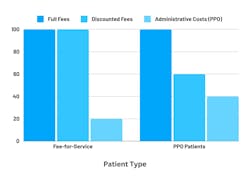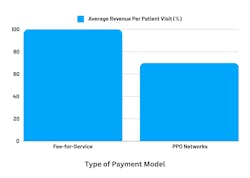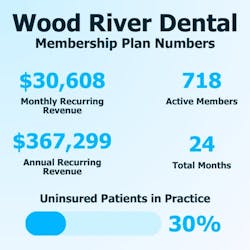In the realm of dental practices, navigating the landscape of insurance networks, particularly preferred provider organizations (PPOs), can be both a boon and a bane. While joining PPO networks may (won’t guarantee) attract a steady stream of patients, the financial implications are often substantial and sometimes detrimental to the practice's revenue. I’ll explore the financial dynamics of PPO networks, their inherent flaws, and strategies for dental practices to optimize revenue through effective marketing systems and innovative membership plans.
The financial impact of PPOs
Offering discounts to only part of your patient base raises ethical and logistical concerns. A primary issue is the disparity between fees charged to patients with and without dental benefit plans. Is it fair for uninsured patients to pay full price while those under a managed care plan receive lower fees (figure 1)? This creates an ethical dilemma for dentists, reminiscent of the frustration when negotiating car prices or comparing disparate rates for the same plane or hotel services. Professionals must stand apart from these common marketing tactics to maintain trust.
Joining a PPO network can seem attractive due to the promise of increased patient volume. But the financial realities for dental practices can be stark. PPOs negotiate fee schedules that often result in lower reimbursement rates compared to what a practice could charge for the same services on a fee-for-service (FFS) basis. This discrepancy can significantly erode profitability, with some practices reporting reductions in reimbursement rates of up to 40% or more on PPO patients.1
Moreover, the administrative burden associated with PPOs, such as claim processing, preauthorizations, and frequent fee negotiations, can strain resources and add operational costs. This creates a scenario where practices must see a higher volume of patients to maintain profitability, potentially compromising patient care quality and practitioner satisfaction.2
Impact of PPOs on average revenue per patient
One critical metric that highlights the financial impact of PPO participation on dental practices is the average revenue per patient (figure 2). PPO fee schedules typically dictate lower reimbursement rates for services compared to what practices could charge through FFS arrangements. According to research, practices in PPO networks report an average revenue reduction of approximately 30% per patient visit compared to FFS models.3
This disparity directly lowers the average revenue generated per patient visit, diminishing overall profitability and making your time in the chair less valuable. The continuous pressure to accept reduced fees within PPO networks can lead to a downward spiral where practices must increase patient volume to compensate for lower per-patient revenue. This scenario not only strains resources but also compromises the quality of patient care due to rushed appointments and reduced time spent with each patient.
Flaws in the PPO business model
The PPO model fundamentally prioritizes cost containment for insurance companies over the financial health of dental practices. This can lead to fee erosion, which is continuous pressure to lower fees to remain competitive within the network; patient steering, meaning encouragement for patients to visit in-network providers, limiting patient choice and autonomy; and administrative complexity—cumbersome administrative requirements that divert resources away from patient care.
Optimizing business with effective strategies
To mitigate the financial impact of PPO participation and enhance revenue, dental practices can implement strategic initiatives such as:
Marketing systems: Robust marketing strategies can help attract and retain patients outside of PPO networks. These strategies include digital marketing and using social media, search engine optimization (SEO), and targeted advertising to reach potential patients actively seeking dental services; patient referral programs, meaning incentivizing current patients to refer others through rewards or discounts; and community engagement, which is participating in local events, offering free screenings, or partnering with other health-care providers to increase visibility and trust in the community.
Dental membership plans: A dental membership plan offers an alternative revenue stream by providing patients with discounted rates in exchange for a subscription fee. Key benefits include predictable revenue as the monthly or annual fees provide steady income regardless of insurance fluctuations; patient loyalty, which encourages patient retention and increases the likelihood of treatment acceptance due to reduced financial barriers; and administrative simplicity, streamlined billing and reducing paperwork compared to insurance claims.
Implementing a dental membership plan
Creating an effective dental membership plan involves:
- Plan design: Define tiers of service and associated fees that balance affordability for patients with profitability for the practice.
- A marketing campaign: Promote the plan through various channels to both existing patients and the broader community.
- Patient education: Clearly communicate the benefits of the membership plan, emphasizing long-term savings and enhanced care options.
- Software tools: Tools that can easily help your practice create, organize, and grow a healthy membership program for your dental practice.
The importance of implementing a membership plan
In today's competitive dental market, the urgency to establish and grow your practice cannot be overstated. The landscape shaped by PPO networks increasingly threatens practice viability by eroding profitability and limiting patient treatment options. Without proactive measures such as a membership plan, practices risk:
- Long-term financial instability: Dependence on PPOs can compromise practice sustainability as fee reductions and administrative burdens escalate.
- Patient attrition: Patients seeking alternatives to traditional insurance may seek care elsewhere, impacting practice revenue and growth.
- Competitive disadvantage: Practices without membership plans may struggle to differentiate themselves in a market saturated with PPO-affiliated providers offering discounted services.
Case Study: Wood River Dental
Wood River Dental, a thriving practice located in a competitive market, faced the common challenges associated with participating in PPOs. Driven by a commitment to enhance patient care and financial sustainability, they made a strategic shift away from PPO dependency, grew their FFS business, and developed a robust membership plan model with the help of BoomCloud.
Like many dental practices, Wood River Dental initially relied heavily on PPO networks to attract patients. While PPOs provided a steady influx of patients, the practice experienced significant drawbacks. These included fee erosion, meaning the PPO fee schedules resulted in lower reimbursement rates, impacting profitability; administrative burden, because managing PPO contracts and processing claims consumed valuable staff time; and patient limitations, because patients' choices were often influenced by insurance network affiliations rather than quality of care.
Strategy implementation
Recognizing the limitations of the PPO model, Wood River Dental decided to pivot. They launched a comprehensive marketing campaign to promote their membership plan, highlighting its benefits. As this strategy took off, they saw a huge impact on predictable revenue. Membership fees contributed to stable monthly recurring revenue (MRR), reducing financial uncertainty.
They also saw enhanced patient relationships. Members received discounted services and priority scheduling, fostering loyalty and satisfaction. Probably the biggest surprise was the administrative efficiency. Simplified billing processes and reduced paperwork streamlined operations, allowing staff to focus more on patient care.
Now Wood River Dental has a mature business model based on patient membership plans and FFS patients. The benefits speak for themselves (figure 3). Within a year, the practice enrolled more than 800 members, each paying $49 per month, resulting in substantial monthly predictable subscription revenue of $39,200 per month and $470,400 per year.
The shift from PPOs to FFS and membership plans significantly increased average revenue per patient visit, improving overall profitability. Reduced reliance on PPOs stabilized cash flow and minimized the impact of fee negotiations and reimbursement cuts. Members appreciated the affordability and transparency of the membership plan, leading to higher retention rates and positive online reviews.
While PPO networks can provide a steady patient flow, the financial trade-offs often lead dental practices to explore alternative revenue strategies. By leveraging robust marketing systems and implementing a well-designed dental membership plan, practices can optimize revenue, reduce dependence on PPOs, and maintain a focus on delivering high-quality patient care. Ultimately, the key lies in balancing patient acquisition with sustainable financial practices that uphold the integrity and profitability of the dental profession.
Free Resources to learn more
The BoomCloud Dental Business eBook Library: BoomCloud offers a collection of free dental business eBooks designed to help dental practices increase revenue and improve patient experiences. These resources provide strategies on creating and growing membership plans, marketing, social media engagement, and patient acquisition. With practical insights and expert advice, these eBooks have been downloaded over 60,000 times, aiding practices in generating significant revenue.
Dentistry Unmasked Podcast: Dentistry Unmasked is a podcast by Dental Economics that delves into the candid, unfiltered side of dentistry. Hosted by industry experts, it explores the real-life challenges and triumphs of dental professionals. Topics include practice management, clinical advancements, and personal stories that reveal the true essence of the dental profession. The podcast aims to provide listeners with practical advice, inspiration, and a deeper understanding of the dental industry’s complexities.
The Automatic Patient Podcast: Dive into the world of dental innovation with The Automatic Patient Podcast. Listen as they uncover the secrets to streamlining dental practices through innovation. From savvy dental membership plans to cutting-edge practice management, there’s a treasure trove of expert insights and actionable tips. Each episode is packed with advice from industry experts to turbocharge your practice's efficiency and profitability.
References
1. Burger D. California Dental Association files legal action against Delta Dental of California. American Dental Association News. January 13, 2023. https://adanews.ada.org/ada-news/2023/january/california-dental-association-files-legal-action-against-delta-dental-of-california
2. Maggio JJ. How I dropped a PPO, without losing a patient. Dental Economics. May 1, 1999. https://www.dentaleconomics.com/practice/article/16394126/how-i-dropped-a-ppo-without-losing-a-patient
3. Aseltine RH, Reisine S, Schilling EA, Kennedy J. Dental practice satisfaction with preferred provider organizations. BMC Health Serv Res. 2007;7:184. doi:10.1186/1472-6963-7-184
About the Author

Jordon Comstock
Founder, BoomCloud
Jordon Comstock, CEO and founder of BoomCloud, revolutionizes dental and vision care with membership plans. With his health-care administration background and passion for innovative solutions, Jordon has guided health-care practices toward financial stability and improved patient care. Under his leadership, BoomCloud has shifted thousands of practices from traditional insurance to membership models, boosting revenue and patient satisfaction. A recognized health-care industry thought leader, Jordon often speaks at conferences and writes on practice management and patient engagement.





